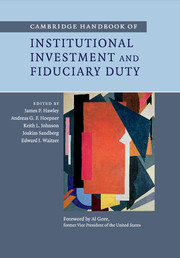Book contents
- Frontmatter
- Contents
- List of figures
- List of tables
- List of contributors
- Foreword
- 1 Introduction
- Part I Fiduciary duty: a global outlook
- Part II Fiduciary duty and the landscape of institutional investment
- Part III Challenging conventional wisdom on fiduciary duty
- Part IV Towards a broader interpretation of fiduciary duty
- Part V Beneficiaries’ roles and viewpoints
- 26 The voice of the beneficiary
- 27 Understanding the attitudes of beneficiaries: should fiduciary duty include social, ethical and environmental concerns?
- 28 Operationalizing socially responsible investment: a nonfinancial fiduciary duty problem
- 29 The preferences of beneficiaries: what can we learn from research on retail investors?
- Part VI Fiduciary duty and governance
- Index
- References
28 - Operationalizing socially responsible investment: a nonfinancial fiduciary duty problem
Published online by Cambridge University Press: 05 April 2014
- Frontmatter
- Contents
- List of figures
- List of tables
- List of contributors
- Foreword
- 1 Introduction
- Part I Fiduciary duty: a global outlook
- Part II Fiduciary duty and the landscape of institutional investment
- Part III Challenging conventional wisdom on fiduciary duty
- Part IV Towards a broader interpretation of fiduciary duty
- Part V Beneficiaries’ roles and viewpoints
- 26 The voice of the beneficiary
- 27 Understanding the attitudes of beneficiaries: should fiduciary duty include social, ethical and environmental concerns?
- 28 Operationalizing socially responsible investment: a nonfinancial fiduciary duty problem
- 29 The preferences of beneficiaries: what can we learn from research on retail investors?
- Part VI Fiduciary duty and governance
- Index
- References
Summary
Introduction
The fiduciary duty principle has taken center-stage in the debate concerning the integration of environmental, social and corporate governance (ESG) performance. For decades, it has been widely agreed that “trustees or fiduciaries [are to manage] assets in the best interests of the individual beneficiaries or investors: the ultimate recipients or owners of the funds” (Chapter 1 of this volume). The “best interests” of the beneficiaries or investors have typically been reduced to their financial interests (Langbein and Posner 1980; Sandberg 2011). Addressing this fiduciary duty problem is seen as pivotal for future development of the socially responsible investment (SRI) market in general (e.g., Richardson 2009). As a result, an ever-increasing body of literature has focused on the analysis of the financial implications of incorporating nonfinancial interests into investment decision-making. Over the past three decades, several thousand “does it pay to be green?” or “does it pay to be responsible?” studies have been published with the aim to shed light on this relationship (for excellent – albeit slightly contradictory – overviews see, for example, Margolis and Walsh 2003; Orlitzky et al. 2003; Salzmann et al. 2005). It is generally agreed that the inconclusiveness within this body of literature is a result of the diversity of the underlying measures of financial performance, the methodologies applied, the sample sizes analyzed, the time horizons under investigation, the respective industries analyzed and, most importantly, the operationalization of the environmental or social performance of the companies under investigation (cf. Horváthová 2010; Ullman 1985).
- Type
- Chapter
- Information
- Publisher: Cambridge University PressPrint publication year: 2014
References
- 2
- Cited by



